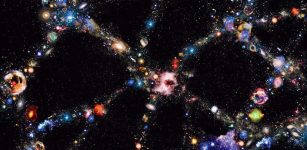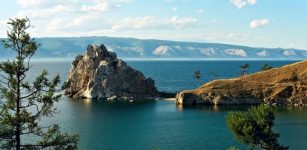Caddo Lake: Home To The Largest Cypress Forest In The World Is Located Between Texas And Louisiana
Cynthia McKanzie – MessageToEagle.com – According to Caddo Indian legend, the Caddo lake was formed by a giant flood. Other theories attribute the lake’s origin to an earthquake.
Scientists believe the lake formed when floodwaters, blocked by massive log jams on the Red River, backed up into the Cypress Bayou watershed, forming the lake.

This fascinating maze of waterways, sloughs, islands, bayous, channels, and cypress thickets dripping with Spanish moss, was named after the Native Americans called Caddo Indians or Caddoans.
Caddo Lake is the largest natural lake in the south, and the only natural lake in Texas, more exactly located on the border between Texas and Louisiana; the area of the lake extends over a distance of about 106 sq. km.

It is fed by Big Cypress Bayou, Little Cypress Bayou, Black Cypress Bayou and Jeems Bayou. Thick bald cypress and a tangle of aquatic plants thrive in the waters at Caddo Lake State Park.
Yet another wonderful legend of Caddo Indian tribe is related to this wonderful place:
‘Once upon a time, a young beautiful girl met a guy and they fell in love. Lovers made a decision to live together and go away from the trib. They lived very happily, walking along lake shores and enjoying its beauty until the woman died of illness. The distressed man buried his beloved but cut off her hair in memory.

He walked along the banks and hung dead girlfriend’s braids on the tree branches. Over time, they turned gray, but still hang on the branches of cypress trees, preserving the memory of immortal love between two people….’
See also:
Fly Ranch Geyser: Nevada’s Marvellous And Unique Oddity
The Hoodoos Of The Towers Of Silence – Mother Nature’s Wonder Work In Southwest, USA
Garden Of The Gods In Colorado Reveals Secrets Of Ancient Environments
Today Caddo Lake is a sprawling maze of bayous and sloughs covering, 26,810 acres of cypress swamp. The average depth of the lake is 8′-10′ with the deep water in the bayou averaging about 20. It contains 71 species of fish. There are also cypress trees, American lotus, and lily pads, waterfowl, alligators, turtles, frogs, snakes, raccoons, minks, nutrias, beavers, squirrels, armadillos, and white-tailed deer.

In the late 18th or early 19th century, Caddo Indians settled on this rich land, where according to tribal legend, ‘water thrown up into the drift along the shore by a wind’ formed Tso’to (Sodo) Lake. Legends tell of the formation of the lake and Sha’childi’ni (Timber Hill), the first and last known Caddo village in this area.
People have lived in this area for at least 12,000 years. For centuries, they hunted and gathered among the wetlands, forests and broad floodplains. Then they began to settle in permanent villages and farmed corn, beans, and squash. They built ceremonial centers and maintained far-reaching trade routes.
In 1835 the land of and around present-day Caddo Lake was purchased from the Indians for $80,000 by the U.S. government, and within a year the Caddo Indians were removed from this region.
Written by Cynthia McKanzie – MessageToEagle.com Staff Writer
Copyright © MessageToEagle.com All rights reserved. This material may not be published, broadcast, rewritten or redistributed in whole or part without the express written permission of MessageToEagle.com
Expand for referencesRelated Posts
-
 Incredible Padmanabhaswamy Temple And Its Ancient Treasures Hidden In Vaults Guarded By Serpents
No Comments | Jun 29, 2015
Incredible Padmanabhaswamy Temple And Its Ancient Treasures Hidden In Vaults Guarded By Serpents
No Comments | Jun 29, 2015 -
 Famous Philosopher Plato: One The Greatest Thinkers Of All Time With Special Interest In The Concept of Soul
No Comments | Sep 28, 2016
Famous Philosopher Plato: One The Greatest Thinkers Of All Time With Special Interest In The Concept of Soul
No Comments | Sep 28, 2016 -
 How Dangerous Are The Biggest Solar Flares?
No Comments | May 5, 2016
How Dangerous Are The Biggest Solar Flares?
No Comments | May 5, 2016 -
 Is Mind Blanking Dangerous?
No Comments | Apr 1, 2019
Is Mind Blanking Dangerous?
No Comments | Apr 1, 2019 -
 Existence Of Time – One Of The Greatest Mysteries Of The Universe
No Comments | Feb 5, 2022
Existence Of Time – One Of The Greatest Mysteries Of The Universe
No Comments | Feb 5, 2022 -
 Boss Great Wall: Gigantic Wall Of Galaxies Located In Deep Space
No Comments | Sep 21, 2016
Boss Great Wall: Gigantic Wall Of Galaxies Located In Deep Space
No Comments | Sep 21, 2016 -
 Lake Baikal Is The Deepest And Oldest Lake In The World
No Comments | Jan 24, 2016
Lake Baikal Is The Deepest And Oldest Lake In The World
No Comments | Jan 24, 2016 -
 It Is Possible To Erase Fear From Your Brain
No Comments | Jan 27, 2017
It Is Possible To Erase Fear From Your Brain
No Comments | Jan 27, 2017 -
 Mystery Of The Vanishing Hitchhiker And Blue Bell Hill
No Comments | Aug 21, 2019
Mystery Of The Vanishing Hitchhiker And Blue Bell Hill
No Comments | Aug 21, 2019 -
 Free Will Is An Illusion – Says Author Of Your Brain Is A Time Machine
No Comments | May 20, 2017
Free Will Is An Illusion – Says Author Of Your Brain Is A Time Machine
No Comments | May 20, 2017
